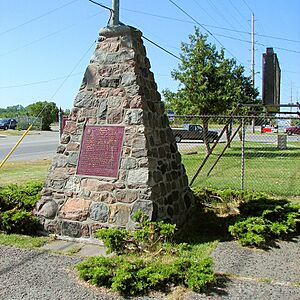Carrying Place, Ontario facts for kids
Carrying Place is a small community in Ontario, Canada. It's like a special entrance to Prince Edward County. This community is located between the towns of Picton and Trenton. It got its name because it's on a narrow strip of land where people used to "carry" their boats between the Bay of Quinte and Lake Ontario. A main road called the Loyalist Parkway goes right through Carrying Place. The community also has a large antenna farm that belongs to the Canadian military base, CFB Trenton.
Contents
History of Carrying Place
Early Portage Route
Long ago, before Europeans arrived, Indigenous people lived in this area. They used this narrow strip of land to move their canoes and boats. They would "portage," which means carrying their boats and supplies over land. This nine-mile journey connected the Bay of Quinte to Lake Ontario. This important route is how Carrying Place got its name.
The 1787 Treaty
In 1787, an important meeting happened at Carrying Place. The Chiefs of the Mississaugas, who were the local Indigenous people, met with Sir John Johnson. He was in charge of Indigenous affairs for the British. They made a treaty where the Mississaugas agreed to share some land and a river. This helped make travel easier across the narrow land between the Bay of Quinte and Lake Ontario.
A Stop for Travelers
Before the Murray Canal was built in 1889, Carrying Place was a very important spot. Travelers going from Kingston to York (which is now Toronto) knew this place well. It was a major stop for stagecoaches on an old road called the Danforth Road. Today, that road is known as the Loyalist Parkway. Even now, Carrying Place is a key point for people traveling. They cross the canal here, which turned Prince Edward County into an island.
Origin of Quinte
The name "Quinte" comes from an Indigenous word, "Kente." You can still see this name in places like Fort Kente and the cities of Quinte and Quinte West.
Notable People
- Lilian Leveridge (1879–1953), a teacher and writer, lived in this area.


